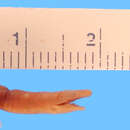Description
provided by AmphibiaWeb articles
Numerous co-types exist. These include the following: BMNH RR. 1946.9.5.44 (1907.10.15.51), altitude 1000 ft; BMNH RR. 1946.9.5.26.30 (1910.3.18.75-79), adult and larvae; BMNH RR. 1946.1.23.5 (1910.3.18.80), skeleton; BMNH RR. 1946.9.5.45 (1910.3.18.74), Mahé; BMNH RR. 1946.9.5.49 (1907.10.15.152), adult, Silhouette; BMNH RR. 1946.9.5.31 (1910.3.18.83), Praslin. These were collected by either J. Stanley Gardiner or J.C. Fryer.Approximately 190 mm in length; tentacle below and anterior to eye, near lip; eyes in socket visible through skin; tentacle twice as far from the nostrils as from eyes; sutural contact between squamosal and parietal; large choanae; narial plugs on tongue; first collar is distinct with an indistinct transverse dorsal groove and none on the ventral surface; 82 primaries and 74 secondaries with a short unsegmented caudal-most region; dorsally, color is black-brown and the ventral surface is more light brown; a light brown spot surrounds each eye, tentacle, nostril, and vent (modified from Talyor 1968).
Distribution and Habitat
provided by AmphibiaWeb articles
Seychelles Islands: Mahé, Silhouette, Praslin.Typically all Grandisonia species are fossorial and can be found under leaves, stones, decaying wood, and in wet soil. G. sechellensis is known from 80 m above sea-level to at least 390 m. Distribution is thought to be limited to the availability of moist habitat rather than elevation.
Life History, Abundance, Activity, and Special Behaviors
provided by AmphibiaWeb articles
Grandisonia sechellensis is probably best considered uncommon. All species of Grandisonia are believed to be oviparous. It has been reported that G. sechellensis has a larval stage.
Life History, Abundance, Activity, and Special Behaviors
provided by AmphibiaWeb articles
A permit is required for their collection. They are potentially endangered by habitat destruction.
Grandisonia sechellensis: Brief Summary
provided by wikipedia EN
Grandisonia sechellensis is a species of caecilian in the family Indotyphlidae. It is endemic to the Seychelles islands of Mahé, Praslin, and Silhouette.
- license
- cc-by-sa-3.0
- copyright
- Wikipedia authors and editors

